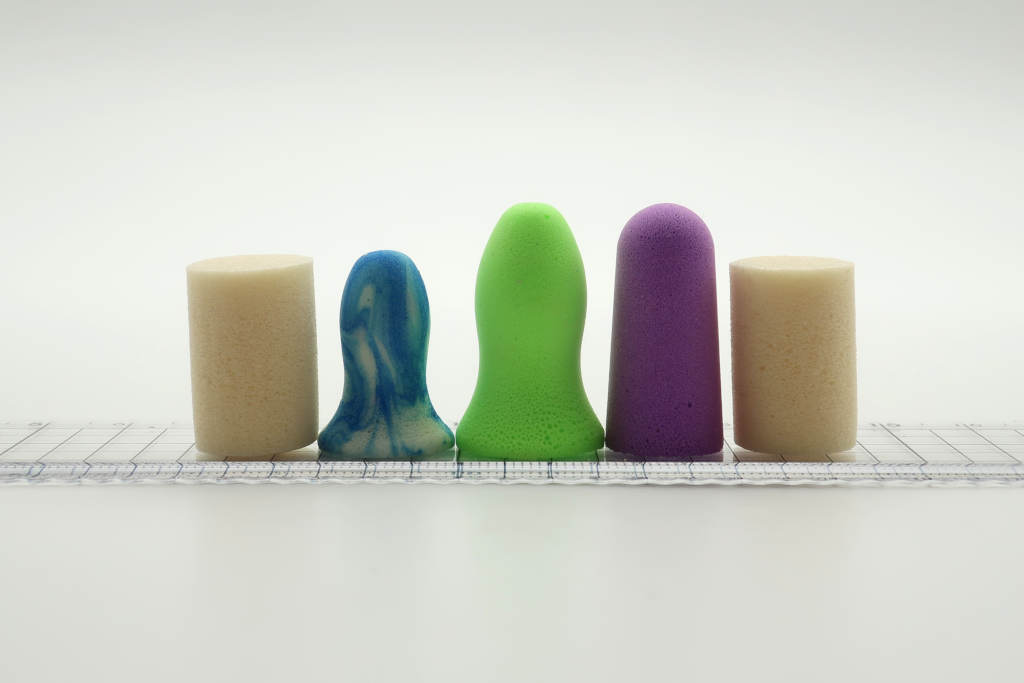
Flents (Apothecary Products) distributes several very different earplugs in their Quiet-series.
The short cylindrical Quiet Please are made of beige PVC. They may look retro, but in my experience, they shine as low frequency noise blockers and exert very little pressure in the ear canal.
The longer Quiet Time (purple) and Quiet Contour (green) are made of softer, but denser polyurethane. They are somewhat more effective overall and more economical because they keep their shape for longer.
These three are among the most popular earplugs on the market, and I like all three.
For this review, I have put them through some detailed testing (noise reduction, size, comfort, ease of insertion).
Note: If you like the shape of the Quiet Contour but have a small ear canal, there is also a mini version of them (blue in the image), the Flents Protechs Earplugs for Sleeping.
Contents
Noise reduction (official+own results)
Official noise reduction ratings for these earplugs
The stated U.S. noise reduction ratings (NRR) for the Quiet Time, Quiet Contour, and Quiet Please are 33, 33, and 29 decibels respectively.
These are averages for 10 test persons in a lab with an experienced experimenter inserting the earplugs. The tested frequency range used to calculate the NRR is from 125 Hz to 8 KHz.
The noise reduction rating was designed to allow users exposed to potentially damaging noise levels to quickly assess whether a hearing protector is effective enough for protecting their hearing.
So as a hearing protector, the Quiet Time and Quiet Contour are rated 4 decibels higher than the Quiet Please.
But, you have to be aware that the real noise reduction varies widely among different folks.
In particular with earplugs, I like to think of the NRR more as a performance potential rating.
To make foam earplugs work well, you have to be able to insert them (almost) completely into your ear and still be comfortable.
If the earplugs are too large for your ears or expand too fast, you won’t get a good seal or only a shallow seal and insufficient noise reduction.
Depending on your ear, you might get better noise reduction with smaller, well-fitting earplugs with perhaps a lower NRR.
Also, the NRR only includes frequency bands down to 125 Hz.
If you are looking for an effective remedy against disturbing low frequency noises <125 Hz, including music bass and traffic rumble, the NRR doesn’t tell you which earplug is going to do better.
Personal noise reduction test for the Quiet Time, Quiet Contour, and Quiet Please
In the following I am reporting on a noise reduction test (narrow band noises at increasing frequencies) using my own ears.
To get a more complete performance picture, I included low frequency noise down to 40 Hz.
Result
- You may be surprised, but for me, the lower-rated Quiet Please (NRR 29) reduce low frequency noise <= 125 Hz substantially better than the other two.
- For this type of noise (but not overall) they outperform the Quiet Time by a staggering 13 decibels.
- The Flents Quiet Time (NRR 33) and Quiet Contour (NRR 33) earplugs perform about the same across the whole tested range.
- For higher bass (>=160Hz) , mid, and high frequency noise the Quiet Time and Quiet Contour are more effective, but the Quiet Please hold their ground well.
The following table shows noise reduction averages (arithmetic, my ears) for all three earplugs:

Noise reduction test result graph
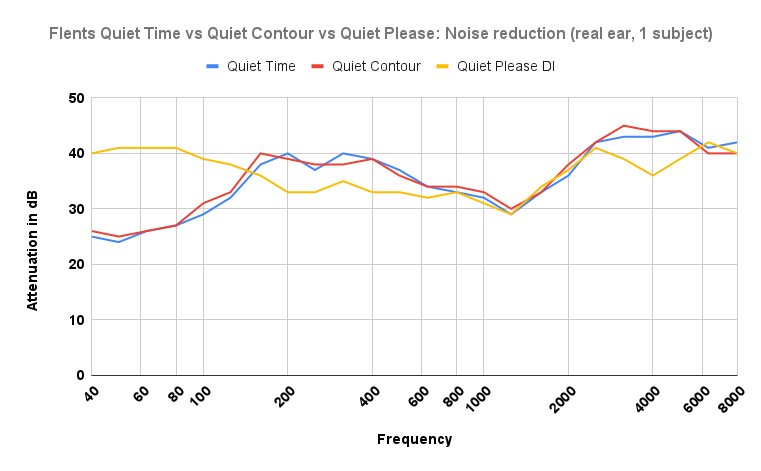
Ranking general noise reduction (125 – 8000 Hz)
- Quiet Time/Quiet Contour
- Quiet Please
Ranking low frequency noise reduction
- Quiet Please
- Quiet Time/Quiet Contour
Comfort
While the Quiet Please earplugs (PVC) feel stiffer and coarser in the hand, they exert the least pressure in my ear. I can completely forget them.
The Quiet Time and Quiet Contour are made of polyurethane foam and have a softer feel, but they are actually denser and I can feel them more.
All three are comfortable, but my ranking is:
- Quiet Please
- Quiet Time
- Quiet Contour
Earplug size and your ear
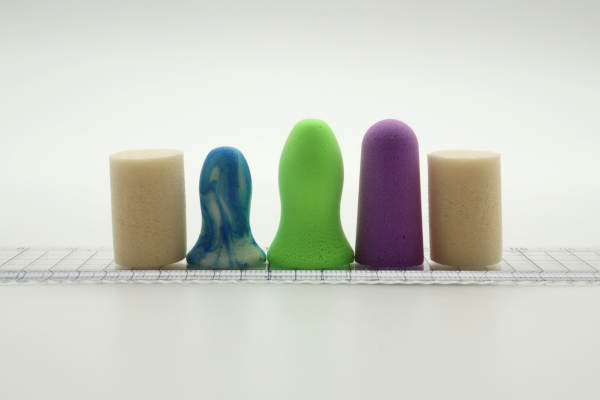
The Quiet Please (beige) are ideal for people with shorter ear canals.
They do work for longer canals (like mine); in that case they just become a bit more difficult to get out.
But, if you need bass noise reduction, they may well be worth that inconvenience.
Take a look at my post How to Make Your Earplugs Block More Low Frequency Noise for info on how deep to insert them and check that they work well against low frequency noise.
The Quiet Time (purple) and Quiet Contour (green) are substantially longer and geared towards people with an average-size ear canal. If yours is short, they may stick out a bit much for side sleeping.
For comparison, I have also included the Flents Protechs Sleep (NRR 28, blue), the miniature version of the Quiet Contour. These are for people with a small ear canal.
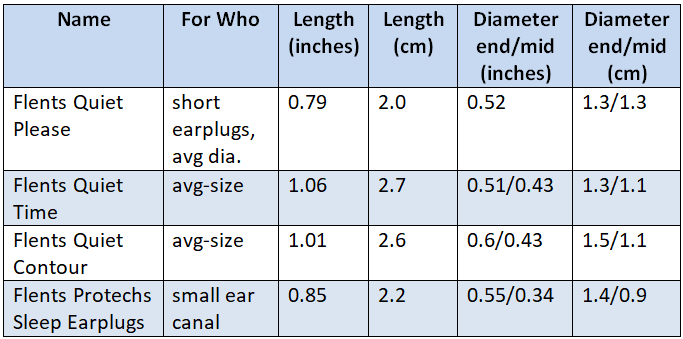
How easy are they to insert?
For most foam earplugs, I recommend rolling up the entire earplug (how to with images) so that you can make use of its full length and completely insert the plug.
The Quiet Time and Quiet Contour are made of similar-density polyurethane foam and expand very slowly after rolling them up.
Of the three, the Quiet Time earplugs are the easiest to roll up and insert. Their bullet-like shape and a firm enough material allow you to wiggle them around bends and fully insert them.
The Quiet Please are coarser and initially appear to be a bit stiff. They become soft when in the ears but they take longer to roll up.
You compress the Quiet Please by gradually increasing pressure while rolling the plug (e.g., between your thumb and index finger).
They expand a bit faster than the other models of the Quiet series, but they still give you time.
(They are definitely not like some of the cheap no-name foams that expand in an instant.)
I just had to practice a bit more to get the hang of it.
Use lubrication to make the Quiet Please (and other earplugs) slide in easily
- Dip your pinky in water and moisturize the ear canal entrance a bit. Use only a little water, otherwise the plug will soak it up and become mushy.
- Alternatively, a sparingly applied earplug lubricant works even better.
Ease of insertion ranking
- Quiet Time
- Quiet Contour
- Quiet Please
Conclusion
If you are bothered by low frequency noise (e.g., music bass, trucks, hums) or have a short ear canal, I recommend the Quiet Please. They also exhibit the least pressure in the ear canal of the three and are more forgiving if you can’t insert them quite as deep.
Try the Quiet Time if you have a normal-size ear canal and your focus is on maximizing mid frequency noise (e.g. barking, TV from an adjacent room, chatter) or high frequency noise reduction (e.g., crickets, birds, screaming).
Also, they keep their shape much longer than the Quiet Please, so they are more economical over time. Moreover, they are easier to roll up and give you a bit more time when inserting them.
I see the Quiet Contour as a specialty pick if you have an average-size ear canal but other earplugs tend to fall out of your ears. They are good earplugs and for me they are as effective as the Quiet Time, but a tad less comfortable (still comfortable though).
Also, they are not quite as easy to roll up and insert.
For other options for a normal-size ear canal, also read my post Earplugs for Sleeping and a Way to Boost Their Performance.
If you have a very small ear canal, the Flents Protechs Sleep Earplugs (NRR 28) are amongst the smallest earplugs I have come across. They are the mini-version of the Quiet Contour, and while somewhat less effective, they are still good.
Also check my post The 5 Best Earplugs for Small Ears for other small ear-canal options.


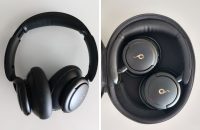
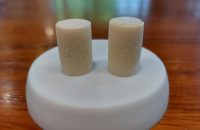
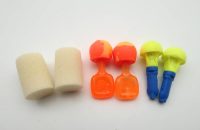
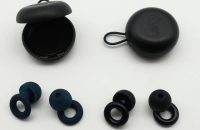

Hi,
Thank you for having so many reviews on earplugs, I recently bought the Flents Quiet Please. It’s really more difficult to roll into a thinner cylinder but it’s so much more comfortable than the Protechs earplugs for sleep (the white and blue ones).
But the Flents Quiet Please are too big for me and I love the size of Protechs earplugs for sleep. Do you have recommendations for PVC foam earplugs for a small ear canal?
Thank you so much.
Hello Eleen,
the 3M EAR Classic Small (310-1103) (aka Amigo) would be an option. They are the smaller brother of the 3M EAR Classic (the original foam earplugs). The Quiet Please are sized like the regular Classic.
However, if you are comfortable with the Quiet Please, and it is just the rolling down that bothers you, it does get easier over time.
Also, at times I dip my pinky in a bit of water (or use an earplug lubricant) and apply that to the the ear canal entrance (more precisely, the place that feels bony when you plug your ear with your pinky).
Have a great day.